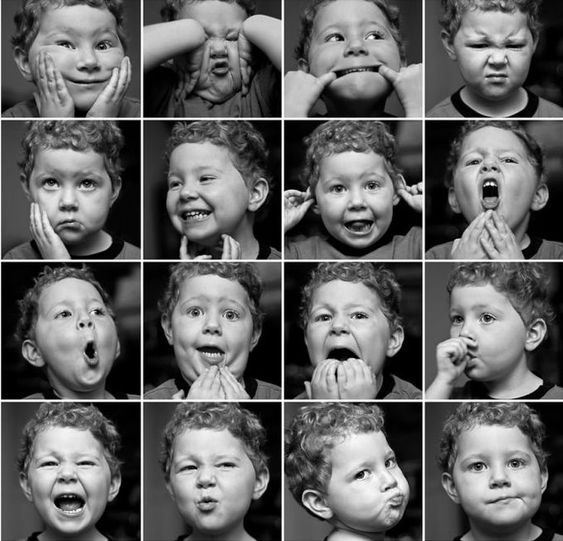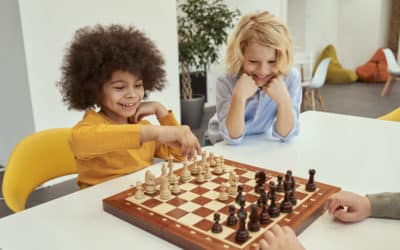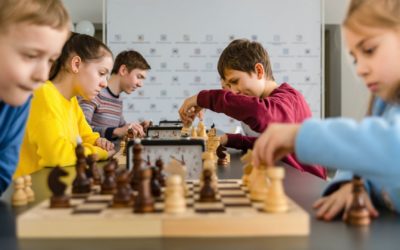Encouraging children to take part in an extracurricular activity is always an excellent initiative. Among the various options available, an introduction to the dramatic arts stands out for its many benefits. To immerse your children in this captivating world, Kidlee offers ten mini-games designed to introduce them to theater for children, allowing you to create your own extracurricular activity at home. Turn your afternoons into theater classes by taking on the role of director.
The benefits of children's theater
The children's theater is particularly beneficial for children who are shy or afraid to express themselves. What are its benefits?

Develops verbal and physical expression
Theater enriches vocabulary. Children learn to express themselves more fluently and clearly. As well as developing verbal expression, non-verbal expression is also worked on.
Little by little, children become aware of their bodies, and understand that their movements and gestures conceal another type of communication that they have fun developing.
Children's theater boosts self-confidence and reduces shyness
The children's theater is a powerful tool for strengthening self-confidence and reduce shyness. By engaging in theatrical activities, children develop essential skills that foster their personal and social development.
Participating in theatrical productions encourages children to collaborate, communicate effectively and support their peers, building team spirit and reducing shyness.
Learn patience: you don't become an actor overnight!
Encouraging a child to be diligent, to practice while having fun and learning is essential to his overall development. With every effort, they acquire more knowledge, fluency and experience. As children see their progress, their self-esteem grows.
Children's theater stimulates creativity and imagination
The children's theater plays an essential role in a child's development, stimulating creativity, imagination and emotional intelligence. By engaging in theatrical activities, children explore various aspects of their personality and acquire valuable skills for personal growth.
Types of theater for children

Introduction to children's theater generally takes place in three stages:
- Body expression Children learn to use their bodies to communicate emotions and ideas, developing their non-verbal language.
- Dramatic games and improvisations This phase encourages children to explore different situations and characters spontaneously, stimulating their creativity and adaptability.
- Working on a text Children learn to interpret scripts, improving their understanding of narrative structure and verbal expression.
Among the different types of theater KidsActivities summarizes in a simple way 9 forms :
1. Improvisation
Children, with the help of parents or their babysitter create spontaneous scenes based on suggestions, developing their imagination and reactivity.
2. Mime
This form of children's theater uses only facial expressions and body language to tell a story, without recourse to speech.
For your children 30 mime cards to download.
3. Dramatic games
Children use their imagination to represent different situations or worlds, sometimes incorporating dance, art or music.
In a dramatic play, you inhabit a different world than the one you live in. In addition, you use your imagination to represent or dramatize something.
Beyond the children's theaters, dance, art, music, sport or any other type of activity can also be used.
4. Role playing
Each child plays a specific character in a play, helping to build empathy and understanding of other people's perspectives.
5. Masked drama
Children wear masks and interpret their roles using only their voices and bodies, emphasizing non-verbal communication.
6. Puppet games
Using puppets allows children to express ideas or feelings they might be too shy to share directly. There are many puppet games available to download online. In fact, we've chosen this puppet theater to download and cut out at home.
7. Reader's theater for children
Children read and interpret scripts or stories, using their voices, facial expressions and gestures to bring the characters to life.
8. Radio drama
This activity is identical to Reader's Theater, but with the addition of sound effects to create a mood, encouraging children to paint mental pictures through sound.
9. Poetry of the show
The children recite poems while interpreting them, combining the art of poetry with theatrical performance.
These different forms of theater offer children a variety of experiences to develop their verbal and physical expression, self-confidence and creativity.
Children's theater : Top 10 mini-games
To boost the children's theatrical spirit, we can set up little games.

The mirror game
This game is played in pairs. Player "A" is the follower, or mirror, while player "B" initiates all actions. "A" must faithfully reproduce all the movements and facial expressions of "B".
This exercise stimulates creativity, clown spirit and a sense of timing. It's important to encourage children to be as precise as possible in every gesture. Once "B" has finished, it's "A"'s turn to take the initiative.
Expression game to introduce children to theater

This game helps participants overcome their fears and feel more relaxed and at ease with themselves. To begin, the whole group should form a circle, holding hands (if there are more than two children).
Then, one person in the circle turns to the person to his or her right and makes a grimace - it could be an emotional expression or a comical face. The next person must then show a new facial expression and pass it on to the next person, and so on.
Children are encouraged to think ahead about ideas for expressions, which will develop their ability to anticipate.
Children's theater: Mimicking tug-of-war
Two children or two groups of children compete in a tug-of-war. It's essential to ensure that the "mimed rope" remains stable, without stretching or shrinking. At the end of the game, one group will be declared the winner, while the other will lose with dignity.you can designate the participants and the winning and losing teams in advance. For the next round, you can reverse the roles.
Go to the other
The game leader suggests an imaginary object to pass around the circle. If the children prefer, they can agree together on an object that satisfies them all, which is ideal! The object can vary from a small pea to a huge balloon, or even a prickly object.
The object is passed from participant to participant, and the aim is to keep it in the air while indicating its size and weight through actions. The children must express themselves solely through their bodies and facial expressions, without using words. The audience has to guess which object is being represented.
Impro : what happened next ?
One player sits in the center, while the others sit to one side. The seated players assign a task to the central player. Any other player can suggest what happens next, the aim being for the group to build a coherent story.
The player in the middle only has to carry out the instructions given; it's up to the seated players to develop the plot. At the end of the story, roles are exchanged.
Playing a story
Ask the child to choose a story he or she particularly enjoys. They should then prepare to act out a scene from this story. If they wish, they can invent their own lines.
You can also read the story as he plays, taking on the role of narrator. This will enrich the experience and help the child become fully immersed in the story.
Three-tone presentation

The child will have to introduce himself 3 times and with 3 different tones. For example as a hero, as a witch, or with a sad tone.
A variation of this game can be made with a die that will simplify the choice of tones on the one hand.
On the other hand, the initiation of children to the theater will be more fluid!
Each side of the die reveals a tone to use! Download and print free of charge.
Funny form of theater for children: the puppet game

Children are asked to prepare a short puppet show in advance. This activity will give them the perfect opportunity to stimulate their imagination and invent original characters! Once their production is ready, they'll have the chance to present it in front of an audience.
You can also provide them with puppets on the theme of a wonderful tale to enrich their experience and inspire their creativity.
Download and print puppets on the theme of a wonderful tale.
Blind man's game
A child begins by closing his eyes and trusting a guide who orients him by first holding his arm. Gradually, physical contact is reduced. The guide then switches to holding the child by the shoulder, then by the finger, and finally uses only his voice to direct the child.
This exercise encourages concentration, listening and the awakening of the senses. With eyes closed, the child must concentrate, trust his guide and learn to become aware of his spatial environment.
Children's theater: The battle of the wizards
Each opponent simulates sending an impulse to a precise point on his partner's body, from a distance, without physical contact. The other player must react according to the perceived force and intention.
To start with, it's best to take it easy, then gradually increase the intensity of the "spells" cast. This game develops sensitivity, reactivity and concentration while having fun.
To remember :
It's essential to stress that debriefing is a crucial stage in the theater for every child. Each participant must have the opportunity to interpret a role while also being a spectator.
This fosters constructive exchanges and helps children learn to observe, make constructive comments and receive criticism in a positive way.
The mini-game leader, whether a Family or a babysittermust lead by example. He or she will start by complimenting the children's performance, then add a constructive remark that will help the budding actor to perfect his or her acting. This approach encourages a positive, collaborative learning environment.


